by Judy Gonyeau, managing editor

For as long as men and women have been riding animals to transport them from one place to another, they have worn some sort of protection for their feet and legs. All you need is to have one horse put one hoof on one of your feet and you will either be at the nearest boot seller demanding better protection or in the hospital.
Quick Early History
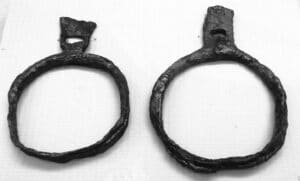
The earliest examples of specialized footwear for riding horses have been found in the tombs in Egypt and were used by those who worked around the horses used with chariots and for the occasional rider to protect their feet.
When the Chinese were working and riding their horses in 300 A.D., the invention of a stirrup helped individuals secure their feet and therefore themselves to the back of a horse when riding across the terrain. They were shaped in circles and were made of iron. The use of a steadier version of riding shoes or boots to use when using the stirrup allowed the rider to apply the needed pressure from the leg to the stirrup to signal the horse where to go and how fast. The stirrup also allowed for some protection when mounting and dismounting the horse by keeping the foot steady – without breaking it.
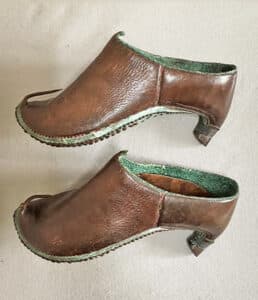
Stirrups were eventually attached to saddles using a piece of leather to connect the two. As the leg moved, it was easy to pinch the leg between the saddle and the stirrup leather which can be extremely painful. So, in the Middle Ages, shoemakers reconfigured the boots to be taller using a stiff/thick piece of leather to keep the leg safe. They were referred to as “Jackboots.”
The Precursor to the Cowboy Boot – Muchas Gracias, Spain
Some of the earliest forerunners of boot design were from Egypt, Spain, Arab countries, England, and Mongolia, creating boots for everyone from the King or Queen to the farmer in the field – and the soldier on the war front.
Long before Spaghetti Westerns existed, the Spanish Cowboys, or “Vaqueros,” were breeding and handling horses and livestock across the mountainous terrain of Andalucia in the South of Spain. Here, they established some of the very best cattle (the Andalusian Black) and horse breeds (the Andalusian) in Europe.
The boots worn by these cowboys were designed to protect the trainer, breeder, and rider, equally. The leather made from the hides of area livestock was considered to be of the best quality, and the quality leather botas (boots) construction worn by the vaquero in Spain were carried over to Spanish Territories established in North America, especially in Mexico and Southern California.
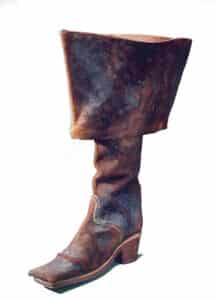
These boots came in three different styles that had either round, pointed, or squared toes with a thick low-profile heel that was later angled forward from the back so the rider, or handler in many cases, could easily maneuver through tasks and tricks on and off the horse during training.
The Advent of the American Cowboy Boot
By the time of the Civil War, military boots had been devised to function well in the stirrup, be as comfortable as possible for both riding and walking, and be easily repairable. Durability was a must, and the workmanship had to stand up to the test of surviving life on the battleground.
While the Hessian and Wellington boots did their jobs during the Napoleonic wars in Europe (1803-1815), the structure and use of a boot in the new post-Civil War times found a new purpose. America’s Manifest Destiny—the 19th-century doctrine or belief that the expansion of the U.S. throughout the American continents was both justified and inevitable—had a profound effect on the clothes, tools, and equipment needed to complete the task of heading West.
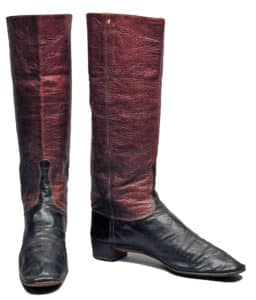
According to timsboots.com, “The first cowboy boot came into existence sometime during the mid-to late-1800s. Searching for a better life after the Civil War, herds of people headed west. What they found was a world of vast landscapes and unforgivable terrain.” Meeting the demands of crossing a country with a family, the tools of a trade, livestock, furniture, food, etc., etc., along with the daily wear and tear of taking care of the horses, fighting off wildlife, negotiating with other travelers, coming across the occasional military outpost, and interactions with Native Americans was no easy feat on the feet.
Timsboots.com states, “Ranchers needed a new kind of shoe. One that could keep them steady on the saddle and shield them from commonplace injuries. That’s when one savvy rancher decided to ask the local cobbler for a custom-made boot. No one knows exactly who this man was, or where the original idea came from, but many suspect Kansas or Texas was the birthplace of the first [cowboy] boot.”
What is known is that the first American store to sell boots was in Coffeyville, Kansas, in the 1870s. These early versions had very high heels that are no longer used today by working cowboys. These boots sold for around $12-$20, a small fortune back then.
The Working Cowboy

Original antique 1860 – 70s cowboy boots. These boots are the early classic two-piece arch front in a brown finish. Brown is far less common than the typical black boot. The sole in the arch is thin to allow a good feel of the stirrup – a feature on the first cattle drives after the war of northern aggression. These boots came out of a museum collection. The sole is stitched on the edge and glued to the inside of the sole. These boot soles were glued and stitched. Cowboys preferred glued
or stitched for comfort
in the stirrup. The use of pegs
were more
common for boots worn by sodbusters and infantry due to the harder wear when afoot.
Cowboys and their Mexican and Spanish counterparts roamed the land daily, herding cattle, troubleshooting weather events that impacted property, and traipsing through prickers and deep water to ensure they could continue to make a living while being out in the open air. They would be in the saddle up to 18 hours a day in every type of weather from scorching heat to freezing cold while working a cattle drive.
These early boots were not meant to be pretty but had to be useful, like any other tool on the saddle or on the pack horse to get the job done. The local bootmaker or “cordwainer” made early versions by hand-sewing cowhide leather – a skill the Cowboy also had in his wheelhouse to repair any tears, or even make a pair of boots for himself.
As people populating the West turned to cowboy boots to wear as they worked in the town and the home, moderations were made to the shape and style of the boot. Some preferred a lower shaft or a shorter heel. One trend that became useful was placing two holes or woven pulls at the top of the boot shaft to make them easier to pull on, and an extended heal at the bottom with a small extension to make them easier to take off when coming into the house.
Welcome to Movieland
Boots were standard footwear throughout the West. When movie production companies were being built in California, some of the first films made to demonstrate the power of the moving picture showed not only the wonders of the world but also the wonder of the Wild West. Perhaps no greater influence shaped the style of the cowboy boot more than Westerns.
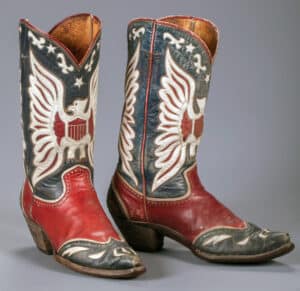
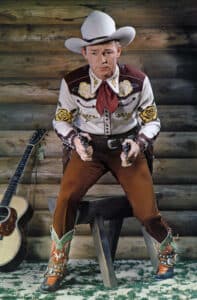
The cowboys were seen as the “good guys,” the heroes of the action film who were not only morally upstanding but standing up in fancy clothes and fancier cowboy boots. The plainer the boot, the more likely the wearer was the bad guy.
Movies made the biggest impact on cowboy boot design and there was some debate as to whether you should tuck your pantlegs into the boots or not. Singing cowboys saw the tucking in of the pant leg as a cleaner approach, keeping the pants clean no matter where they were … not that any mud ever appeared on them, either.
To keep up with the cowboy and cowgirl custom boots made for the stars, boot makers were embellishing the heck out of leather boots – whether it was cowhide, alligator or ostrich leather, or deer and doeskin (synthetics came much later and faded out quickly). In fact, the care and preservation of these fancy new boots created a sub-category of cowboy products sold to the public to help keep boots sturdy, clean, and fashionable. The trick was (and still is) not to apply too much of any one leather conditioner so that the leather would not deteriorate due to the oils in the products.
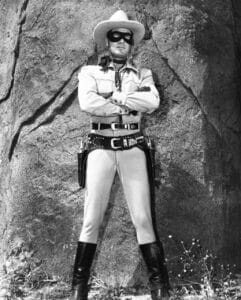
The Lone Ranger radio and television series started in the 1930s and 40s, and then on television in the 1950s and 60s was the epitome of style, honesty, and politeness. Perhaps no one more than Clayton Moore demonstrated this by adhering to strict rules when it came to being in public. Jacquelyn Weaver had the chance to meet Moore as the Lone Ranger in the 1960s. “He was meticulous about his costume, his mask was always on, and his tall black cowboy boots shone like the sun. He wore fringed white gloves the entire time he was meeting his fans. When I was greeting him before he stepped out to the stage at the venue I worked for, I went to shake his hand. Moore insisted he put on his white gloves before he returned the handshake.”
Let’s Go Boot-Scootin’
Next to the clean-as-a-whistle cowboy on film and television, the film industry continues to honor the West with a grittier take on the “real” life out West. According to a corbetosboots.com blog post, in “the 1960s-decade, leather boots experienced another transformation. The youth, at that time, lost interest in the luxurious designs used by their parents and searched for simpler designs, very similar to ones worn by the original cowboys during the 19th Century.”
The boots were taking on mud and muck like never before, and those looking to emulate the “real” cowboy followed suit by picking up single-color boots that were used for any outdoor activity or chore.
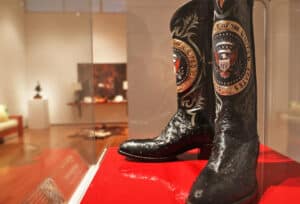
But perhaps one film brought the cowboy look—and boots—back with a vengeance: 1980’s Urban Cowboy with John Travolta and Debra Winger. This marked a boom era that has lasted decades where interest in cowboys, line dancing, and the incredible popularity of country music took the cowboy boot to a whole new level. Suddenly color, dyed leather, intricate stitching, and applique were the order for the day when you were looking for cowboy boots.
Famous bootmaker names like Tony Lama Lucchese, FRYE, Justin, Dan Post, and Ariat boots were on display at local country music venues with plenty of stomping and lots of looking at these fancy new boots.
How long will the cowboy boot continue to rule the footwear industry? As long as there are cattle and horses and cowboys and cowgirls roam the land.
Like Collecting Sneakers
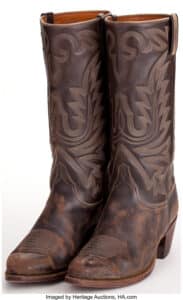
traditional stitching, inside stamped with maker’s logo. Further handwritten annotation in black felt tip ink reading “J.W.” Purposely distressed to look aged; believed to be worn by Wayne as “Rooster Cogburn” in early scenes of both or either film before the action got too rough. Sold for $6,562.50 at Heritage Auctions in 2016.
People who collect historic, trendy, and custom cowboy boots are not unlike people who collect sneakers. Things to look for when investing in vintage cowboy boots include provenance, maker, materials, limited editions, custom-made or factory-made, specialized features, and condition. If a pair was worn by a famous cowboy, a photo of them wearing the boots adds value.
A few of the more valuable cowboy boots tend to be tied to a specific historic moment or person rather than just a pair of old boots. For example, a pair of boots worn by John Wayne and “likely from True Grit and Rooster Cogburn” sold for $6,562.50 at Heritage Auctions in 2016. A pair of Tony Lama custom-made and unworn boots said to be the only pair made in its style, sold for $20,000 at Old West Events.
When shopping for vintage boots to wear, you can look for a comfortable pair of “broke-in” boots that may just be the right size, and you may pay as little as $25 at a thrift shop or flea market for great comfort and style.
The rule is, try them on, and if they fit, buy them.





Related posts: